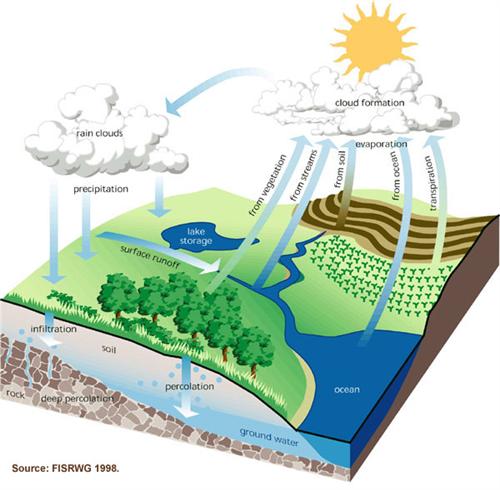The water cycle, or the hydrological cycle, is the continuous movement of water on or below the earth's surface, and between the earth and the atmosphere. Surface water is the water on the earth's surface; ground water is the water beneath the earth's surface; and atmospheric water is water vapor (WSC 2006).
The hydrological cycle is driven by the processes of evaporation, transpiration, and condensation of water vapor in the atmosphere, leading to precipitation and the subsequent movement of surface water and groundwater on earth. Precipitation, in the form of rain, snow, hail and sleet, is how the water in the atmosphere reaches the surface of the earth.

The Hydrologic (Water) Cycle.
Source:Federal Interagency Stream Restoration Working Group 1998
( click to enlarge )
To see an animated version of this diagram, please refer to the Water Cycle Interactive Component.
After reaching the earth's surface, the water can:
-
Percolate through or filter into the soil to become soil water
-
Seep further down to replenish groundwater
-
Accumulate as water in lakes, wetlands or oceans, or as snow or ice as in glaciers and ice shelves
-
Run-off downstream as surface water through streams, rivers, lakes and wetlands
-
Evaporate from soil and water surfaces, or transpire from vegetation (collectively known as evapotranspiration) to become atmospheric water (water vapor)
-
Once it reaches the atmosphere, it cools and condenses, becoming available for precipitation, thereby completing the hydrological cycle
Groundwater recharge is when the water percolates down to the groundwater table. This is a process that often remains ignored, but is an essential component of the water cycle, as it replenishes groundwater resources, allowing for their continued use. To learn more about groundwater and recharge in the Orange-Senqu River Basin, please refer to the Groundwater section of the Hydrology of the Orange-Senqu River Basin.
Water that falls on the earth’s surface, and does not evaporate or become absorbed into the ground is known run off. Surface water run-off follows gravity, flowing downhill to collect in lakes and other waterbodies. This is the water that we see on a daily basis and is most readily available for use in the water cycle.
The surface of standing and flowing water in the water cycle is exposed to the atmosphere. In warm, dry conditions, a portion of this water can evaporate, rising up into the atmosphere as water vapour and forming clouds, and falling back to earth as precipitation.
